Bee hotels are open for business
These structures give wild bees a place to nest — but may bring uninvited guests
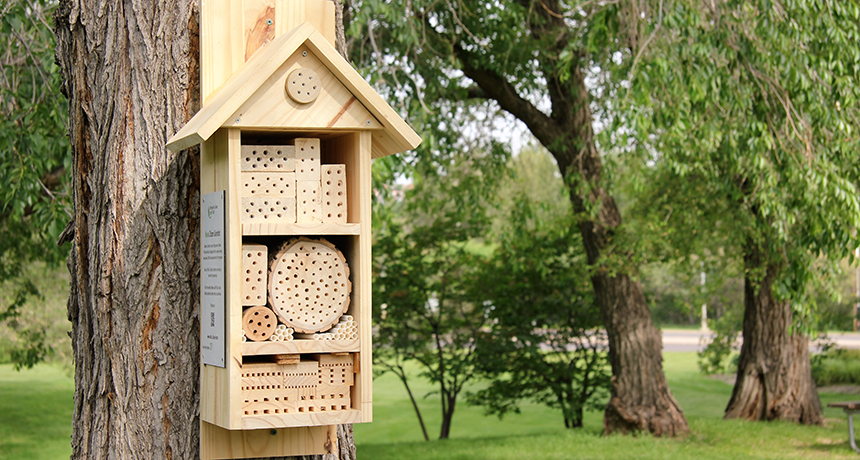
The Edmonton & Area Land Trust’s staff placed this bee hotel in a park in Alberta, Canada.
Edmonton & Area Land Trust
A new kind of hotel is opening for business around the world. Its guests are wild bees. Built by people, these hotels are going up in rural farmlands, in suburban backyards — even on city rooftops. They don’t offer maid service, but they do give bees a place to nest.
Bees are a big deal in the world of plant reproduction. They move pollen from one plant to another, which helps make seeds that will grow into new plants. Some bees make honey. But that’s true only for a certain few species: the honeybees. They live communally in hives, often tended by people. Most bee species are wild and live on their own. (That’s why they’re called solitary bees.)
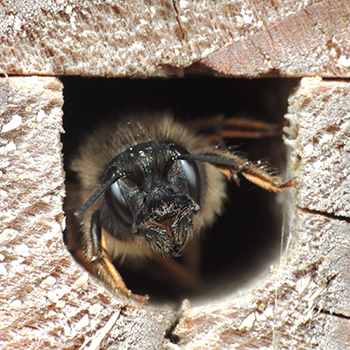
Honeybees aren’t native to the United States. Europeans brought them here roughly 400 years ago. Most wild American bees were here long before honeybees arrived, notes Sandra Rehan. She’s a biologist at the University of New Hampshire in Durham. Estimates show there are about 20,000 species of bees worldwide. About 4,000 call North America home. These insects are incredibly diverse, Rehan points out. “They have lived in these areas and ecosystems for thousands, if not millions, of years.”
Honeybees may be the better-known bugs, but wild bees are crucial pollinators too. “That’s an incredibly important service that they’re providing,” says Daphne Mayes. She’s a graduate student at the University of Kansas in Lawrence. Some bees stop by many types of flowers. Others visit just one type.
Unfortunately, wild bee species have lost much of their natural habitat — the places where they would normally choose to live. Many of those species nest in crevices and holes in the ground. Other nesting spots include gaps under rocks or fallen trees, holes in trees or even cracks in some buildings. Large farms may now plow over such nesting areas. Bee habitats also can be destroyed as people erect cities and suburbs.
Handmade habitats
Bee hotels address one problem caused by that loss of habitat. They give bees a place to nest.
Most guests at hotels for people don’t stay more than a few days. When they leave, they take their stuff with them. But when bees check out of their hotel rooms, they leave their kids behind, observes Scott MacIvor. He’s an ecologist in Canada at the University of Toronto Scarborough. “You can think of a female — a mom — buying a house with several rooms,” MacIvor says. She lays her eggs and leaves food for them to eat after they hatch. By the time her young are ready to check out, they too are now adults.
“It’s actually quite easy to make a bee hotel,” notes Rebecca Ellis. She’s a conservation biologist at the Edmonton & Area Land Trust in Alberta, Canada. The group manages nine parcels of land that are set aside to protect plants and wildlife. Creating bee hotels is so easy that this group already has helped people set up more than 400 in and around Edmonton.
Story continues below image.
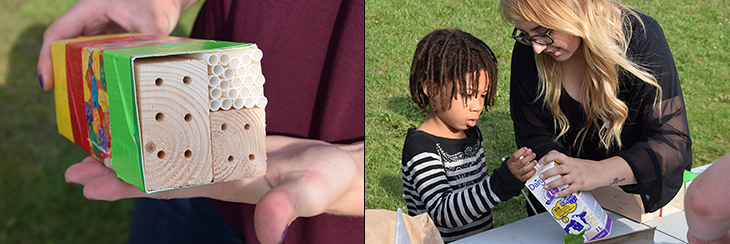
A hotel design can be as simple as paper straws or hollow bamboo stems stuck into a clean milk carton. “Another way is just to drill holes in a block of wood,” Ellis says. Ideally, the holes will reach at least several centimeters (an inch or so) deep into the wood. Female bees lay a line of eggs with food for their young. Then they seal off the hole.
Different species prefer holes of different diameters. Mayes, in Kansas, has been studying bees that nest in tallgrass prairies across the eastern part of her state. Her field stations have become a chain of bee hotels. Among the guests, she found, was a type of leafcutter bee. Called Megachile brevis (MEG-ah-cheel BREH-vis), they nest in holes 12-millimeters (a half-inch) in diameter. A resin bee, Heriades carinata (HAIR-ee-AH-dees KAIR-ih-NAH-tah) uses holes 6 millimeters (a quarter-inch) in diameter. The so-called mason bees will move into either size hole.
You could even add some thin, clear plastic tubes to your bee hotel, suggests Laura Fortel-Vitrolles. She’s an ecologist in France who recently got her doctoral degree from the University of Avignon. For one of her research projects, she studied guests checking into a large bee hotel. “We used [plastic] tubes,” she says. “And we were able to observe bees while they were building their nests!”
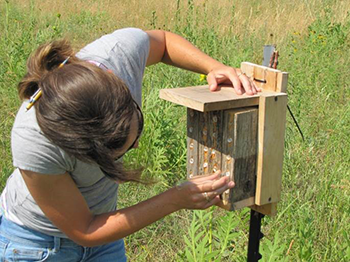
Site a bee hotel in your yard, on a balcony — even a rooftop. “Generally, you want it to get morning sun,” Ellis recommends. Being near native plants — species that evolved in the area, and therefore are suited for it (as the wild bees are) — also helps. Ellis has a bee hotel near some goldenrod and blue flax flowers at her home. “Even your vegetable garden is great, because the bees will help pollinate the vegetables, or your herbs,” she says. “The garden is helping the bees, and the bees are helping your garden.”
Managing a bee hotel is easy. The guests don’t need room service or fresh towels. Nor should they be dangerous to their human helpers. “Solitary bees are not aggressive,” notes Ellis. Leave them alone and they generally won’t bother you.
But keep in mind that any bee hotel is “going to require some management,” Mayes says. Pathogens are germs that can cause disease. And, she notes, “There may be opportunities for pathogens to move from one hole to another and spread.” When many bees visit one spot, they could spread germs just as people can in a crowd. To avoid that, just remove straws, stems or wood blocks from a container after all the bees have left. Then add new ones each year.
Surprise guests
Bee hotels can bring interesting visitors. Fortel-Vitrolles and researchers at the Paris-based French National Institute for Agricultural Research set out bee hotels at 16 sites near the city of Lyon. Over two years, 21 species had visited their hotel chain. But just 87 percent of the bees belonged to just two species. They were the red mason bee, Osmia bicornis (OZ-mee-uh By-KOR-nis), and the builder bee, O. cornuta (Kor-NU-tuh).
Those bees are what scientists call “gregarious” species. Explains Fortel-Vitrolles, “They do not interact much with each other, but they live next to each other.” Think of them, she says, as strangers willing to move into a “kind of an apartment block for bees!”
In this part of France, red mason and builder bees emerge from their nests earlier in the year than do many other species. “They nest everywhere they can,” Fortel-Vitrolles learned, leaving fewer nesting spots for the bees that come out later. Her group shared its findings, last year, in the Journal of Insect Conservation.
Another study showed that native bees probably won’t be the only insects at many bee hotels. MacIvor and Laurence Packer at York University, in Toronto, collected data from almost 600 bee hotels that had been set up around that Canadian city.
More than 27,000 bees and wasps checked into the hotels during a three-year period. About one-quarter were non-native bees. Native wasps made up more than a third. That’s not necessarily bad. “These are very docile wasps that exist all around us,” MacIvor explains. And the wasps are “very, very important” because they help control various pests. But their presence could surprise someone who didn’t expect them. His team published its findings two years ago in PLOS ONE.
Bee hotels also could have unintended consequences, MacIvor notes. For example, the large number of insects in one place could invite parasites or predators. And if holes aren’t deep enough, the ratio of male to female bees could change in an area. That’s because some bees lay eggs that will hatch into females if they’re deep in a nest, but males if they’re closer to the outside. If there aren’t enough females, that could be bad for pollination and for reproduction, MacIvor explains.
Not just habitat
These hotels don’t just give bees somewhere to nest. They also can help researchers learn about the behaviors of wild insects. In one study, MacIvor collected leaf bits left in vacated hotel rooms by three types of leafcutter bees. This told him what types of plants those bees preferred to use for nests. He published those findings in the March 2016 Royal Society Open Science.
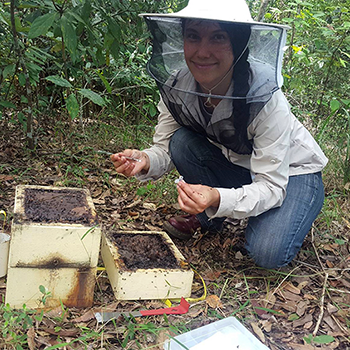
Rachele Wilson is a graduate student in Australia at the University of the Sunshine Coast at Sippy Downs, Queensland. She and other scientists there have been studying what types of pollen wild bees collect. Such data point to what plants those bees rely on, Wilson explains.
For this research, her team placed 24 modified bee hotels in orchards and forests around Queensland. Each hole has a removable straw inside it. That lets Wilson or one of her colleagues sample material from one egg compartment in each hole. Then the straw goes back in the hotel, so the rest of the eggs can develop. The team recently began collecting data.
Bee hotels make it quicker and easier for researchers to get those data, Wilson says. “Instead of watching bees come and go from flowers for several weeks, we can take a small amount of pollen bread [the bee’s food] from each nest every few months and use genetics to figure out which plants those pollens came from.” And, she adds, bee hotels “mimic the nesting material that different species like to use.”
Rehan’s group has a large bee hotel at the University of New Hampshire’s Woodman Farm. For the projects they work on, her team usually doesn’t collect data from the bee hotel. Nonetheless, Rehan says, the bee hotel at the farm is good for the bees that use it. Giving the pollinators comfortable guest quarters also benefits the plants nearby. It even helps the farm’s human visitors learn about wild bees.
Making the public aware of these insects is important because they face plenty of problems. Loss of habitat is a big one. Solitary bees have fewer nesting places as people have been transforming the countryside. The bees also have fewer flowers and other food sources. “They just don’t have enough resources,” says Rehan.
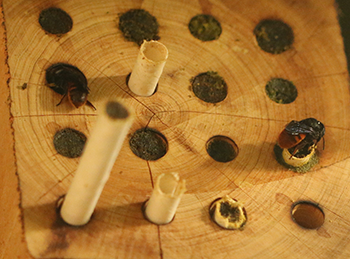
Another problem: farm chemicals. Common pesticides that farmers use may be harming wild bees. One study last year reviewed 18 years of data. The English researchers found evidence linking pesticide use to a drop in the number of wild bees. The group’s study appeared in Nature Communications.
Scientists from three U.S. Geological Survey laboratories also have reported that pesticides pose a risk to native bees. They collected the pollinators from Colorado wheat fields and grasslands. Tests of these bees turned up residues — in some cases high levels — of 19 pesticides and breakdown chemicals. And even the insects roaming open grasslands had been exposed to these pest-killing chemicals. Michelle Hladik, Mark Vandever and Kelly Smalling shared their findings in the January 2016 Science of the Total Environment.
Bee hotels won’t solve all the problems facing wild bees. But they can help these insects and the plants that they typically pollinate. Those hotels also can be fun to craft. And watching as bees or other guests visit to lay eggs — and then emerge the next year as adults — can offer even more fun.
The hotels also help scientists and the public alike learn more about wild bees. Bees “do wonderful work,” Rehan says, yet even today “we just don’t know much about them.”







